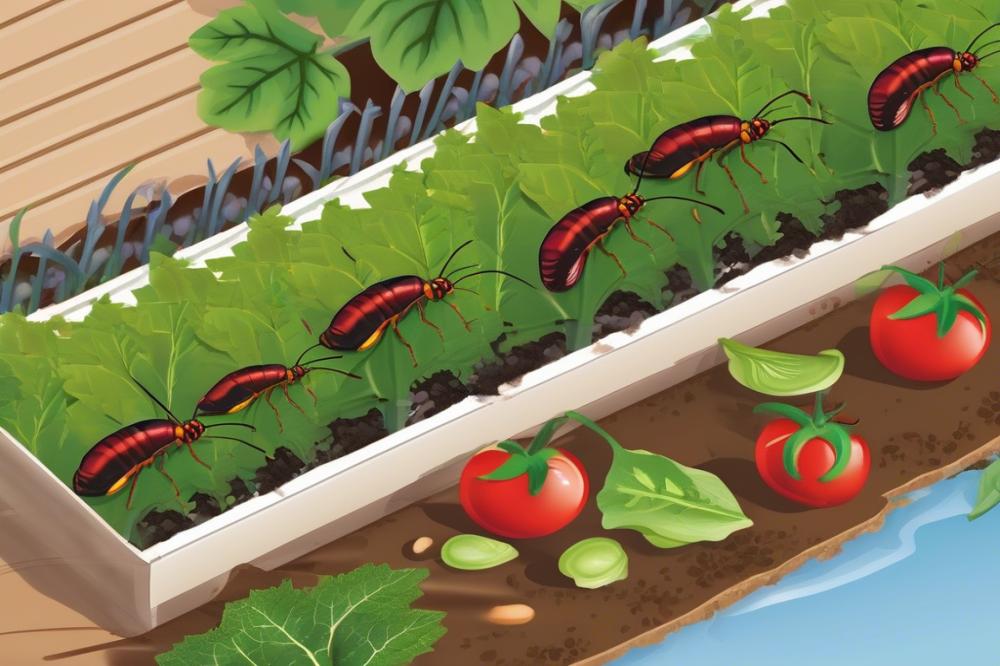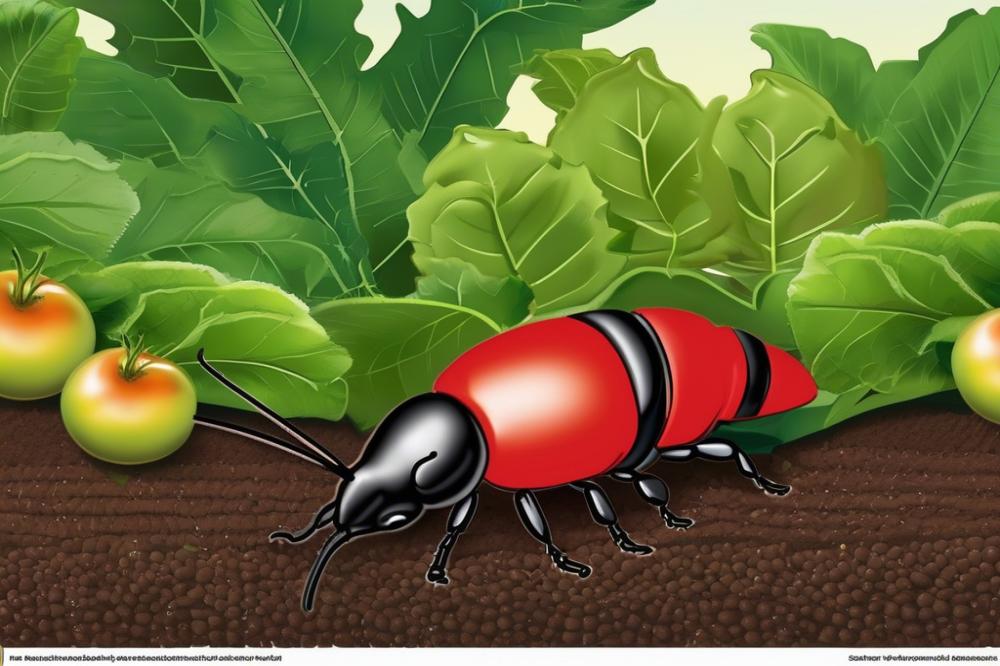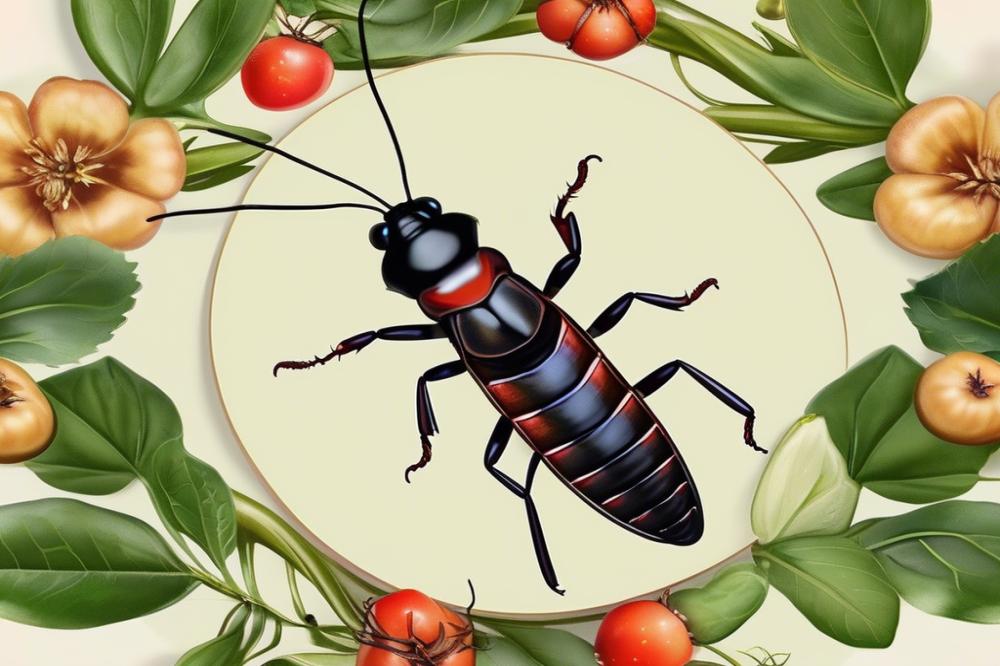Understanding Earwigs
Earwigs are often considered pesky garden pests. Many gardeners find them lurking among their vegetables and plants. These insects can cause significant damage if left unchecked. They tend to feast on soft fleshed fruits and tender young leaves. This can lead to frustration for anyone trying to grow a successful garden.
Taking steps for earwig control is crucial in safeguarding your garden produce. When earwigs invade, your harvest may dwindle, leaving you with little to show for your hard work. Homegrown vegetables are often at risk, especially in moist and shady areas of the garden.
This article will focus on effective prevention and management strategies. We’ll explore organic pest control techniques and various repellent methods. Traps and natural remedies will also be discussed. Proper garden care, including soil management and garden hygiene, plays a key role in reducing earwig populations. Additionally, we’ll share practical tips aimed at protecting your plants. By following these guidelines, you can maintain a healthy and vibrant garden.
Understanding Earwigs


Earwigs are small, flattened insects with distinctive pincers on their rear. They belong to the Order Dermaptera and are often mistaken for other pests due to their shape and size. Generally, they measure about 1 to 1.5 inches long and have a brownish color. This insect’s long antennae and wings can make them appear more intimidating than they are. However, most earwigs are harmless to humans.
Description and Behavior
These nocturnal creatures typically stay hidden during the day. They prefer dark, damp environments, often hiding under mulch, leaves, or stones. When night falls, they emerge to search for food. Earwigs have a rather opportunistic diet. They feed on decaying organic material, but they can also munch on tender garden plants. This behavior can lead to concerns among gardeners.
Common Species in Gardens
Several species can invade gardens. The European earwig is one of the most commonly spotted. It tends to thrive in gardens, especially those with plenty of moisture. Another species is the brown earwig, which shares similar habits. Both species can damage young seedlings and flowers, impacting your harvest.
Life Cycle and Feeding Habits
Understanding the life cycle of earwigs is crucial for effective management. They generally lay eggs in the soil during spring. These eggs hatch into nymphs, which resemble adults but are smaller and lack wings. As nymphs mature, they molt several times before reaching adulthood. Feeding habits vary with their stage of growth. Young earwigs primarily consume decaying plant matter, while adults can eat soft parts of living plants as well.
Garden care is essential to limit infestations. Keeping the area clean and practicing good garden hygiene can make a difference. organic pest control measures, such as beneficial insects, can help keep earwigs in check. Moreover, employing repellent methods, like diatomaceous earth, can deter these pests from targeting your plants. Traps, like those filled with vegetable oil, catch earwigs effectively and can reduce their numbers significantly. Always consider various natural remedies and soil management to foster a healthy garden environment. Plant protection practices include maintaining healthy plants that are less susceptible to damage can also reduce the impact of these pests.
Signs of Earwig Infestation


When you step into your garden, you might notice something is off. Recognizing the signs of an earwig infestation early is crucial for protecting your plants. These pests are often nocturnal, sneaking around when you least expect it. At night, they come out to munch on your precious garden produce.
Indicators of Earwig Presence in the Garden
Look for small, brownish insects with long pincers. Their distinctive shape makes them easy to identify. Another clue is the presence of droppings that resemble tiny black specks on leaves or soil. Additionally, earwigs love damp environments, so check moist areas in your garden. If you find them hiding under mulch, rocks, or garden debris, you likely have a problem.
Damage Symptoms on Plants and Produce
Earwigs are notorious for causing damage to tender plants, leaving behind ragged holes in leaves. You might also notice slim trails on fruits or vegetables, indicating these pests have been feasting. When produce becomes damaged, it can attract other pests, causing even more issues for your garden care regimen. In severe cases, entire plants may begin to wilt and die as they fail to thrive due to constant nibbling.
How to Differentiate Earwig Damage from Other Pests
When assessing plant damage, don’t rush to conclusions. Pests like caterpillars and beetles also leave their marks, but their damage differs. Caterpillars tend to consume entire leaves, while beetles may scrape away on the surface. Look closely at the size and shape of the bites. Earwig damage usually appears as irregular, jagged holes that are not uniform in style. Observing the time of day can help too. If pests are active at night, it might indicate earwig activity.
Integrating effective garden hygiene practices is essential in managing these pests. Maintaining healthy soil management can also offer your plants a solid foundation. Apply natural remedies and repellent methods to help deter earwigs before they become an issue. Traps set in strategic spots can also aid in capturing these troublesome insects. Whenever dealing with pests, consider using organic pest control methods if possible. These approaches help keep your garden flourishing and free from harmful chemicals.
Effective earwig control Strategies


Managing earwigs requires a thoughtful approach. Integrated pest management techniques can be very effective. These methods focus on using a combination of control measures. Relying on one method alone often leads to limited success. By implementing multiple strategies, you can create an overall plan that targets these pests.
Overview of Integrated Pest Management Techniques
Integrated pest management, or IPM, combines several strategies for best results. It often begins with monitoring pest levels to assess the problem. Gardening practices like plant rotation can disrupt earwig habits. You can also use traps to capture these insects. Consider both physical traps and natural remedies like diatomaceous earth. This organic pest control method can keep their numbers down without harmful chemicals.
Importance of Garden Care and Maintenance
Regular garden care is vital in preventing infestations. Keeping your garden clean can make a significant difference. Remove any decaying plant material immediately. Earwigs often hide in damp, dark places. By maintaining garden hygiene, you can reduce their hiding spots. Healthy plants are less likely to be damaged. Strong plants can better withstand pest pressure, which is crucial for their success.
Soil Management Practices to Deter Earwigs
Soil management plays a key role in earwig prevention. To start, consider improving soil drainage. Earwigs thrive in moist environments, so dry conditions can limit their population. Incorporate organic matter to promote healthy soil. This will also help plants resist pests naturally. Adding beneficial nematodes to the soil can kill earwig larvae. This natural remedy fits well within an eco-friendly gardening approach.
In addition to this, using mulch strategically can hinder earwig access to plants. Choose mulches that are less inviting for these pests. Cedar chips, for example, have a natural repellent quality. Following these prevention tips will improve your chances of a thriving garden without unwanted visitors.
Organic Pest Control Methods


Benefits of Using Organic Techniques for Earwig Management
Choosing organic pest control strategies for your garden provides many advantages. Plants thrive better when protected by natural solutions. Not only are these methods safer for families and pets, but they also promote a healthy ecosystem. Chemical insecticides may damage beneficial insects, while organic techniques focus on maintaining balance. Healthier soil can lead to stronger plants, which are less susceptible to pests. This approach is also better for the environment, contributing to sustainable garden care.
Natural Remedies to Repel Earwigs and Protect Plants
Numerous natural remedies exist to keep earwigs at bay. A common strategy is using homemade repellents. Certain scents, like citrus and peppermint, can deter these pests effectively. Spraying a mixture of water and essential oils around your plants can create a protective barrier. Coffee grounds may also serve as a deterrent, as many insects dislike their smell. Moreover, maintaining good garden hygiene can limit attractants that draw in earwigs.
Examples of Homemade Repellents and Their Application
Creating your own repellent is simple and rewarding. A popular recipe involves mixing soap and water. Use one tablespoon of liquid soap in a spray bottle filled with water. This solution can be sprayed directly onto the affected plants. Another option is to soak citrus peels in water for a day and then spray this mixture on your garden.
Traps can also play a role in your organic pest control strategy. A jar half-filled with beer can act as bait. Earwigs are attracted to the smell and will fall in, unable to escape. Place several of these traps around your garden to monitor and manage earwig populations. Combining traps with proper soil management can enhance plant protection while minimizing insect damage.
Incorporating these techniques into your garden care routine can promote healthy growth and discourage earwig infestations. Follow these prevention tips, and you’ll find that your garden remains beautiful and productive despite the presence of pests.
Traps and Baits for Earwig Control
Creating effective traps for earwigs can be an easy and proactive step in your garden care. You can use simple items like a dry, hollowed-out fruit or a small container filled with oil. Setting these traps in the evening works well since earwigs are nocturnal. The smell of the fruit lures them in, but once inside, they struggle to escape. Always check your traps daily and dispose of any caught insects to keep them from returning to your garden.
There are various commercial bait options available for gardeners. Some products come with attractive scents that draw earwigs toward them. These baits often contain ingredients that not only attract these pests but also kill them. When using these products, it’s crucial to follow the instructions carefully for optimal effectiveness. Incorporating these baits into your pest management plan can yield better results in conjunction with other preventive measures.
Best Practices for Trapping and Monitoring
Monitoring earwig populations can give you a clearer picture of your garden’s health. Regular inspections can help in identifying the areas where earwigs are most active. If you notice increased activity, it might be time to set additional traps. Maintaining good garden hygiene also plays a vital role in fighting these pests. Removing debris and keeping the area tidy reduces hiding spots and breeding grounds.
Consider using natural remedies along with traps. For instance, a mixture of water and soap sprayed around the garden can repel earwigs. This organic pest control method disrupts their movement and encourages them to stay away from your plants. Soil management is equally important; healthy soil makes for strong plants that can better withstand pest damage.
Implementing diverse strategies, such as traps, baits, and repellent methods, offers the best chance of keeping earwigs at bay. Always read labels on any insecticides to understand their effects on beneficial creatures in your garden. Taking these steps not only protects your plants but also contributes to a more balanced ecosystem.
Using Insecticides Responsibly
Selecting the right insecticides can be crucial for protecting your garden produce from earwigs. Not all chemicals are created equal, and some can be more harmful than helpful. Start by looking for insecticides specifically labeled for earwig control. Always read product labels carefully. Pay attention to the active ingredients and follow the recommended usage guidelines.
Guidelines for Selecting and Applying Insecticides
Choosing the best product involves understanding your options. Organic pest control methods often provide a safer alternative. Many people prefer using natural remedies such as diatomaceous earth or neem oil. These substances can deter pests with less risk to beneficial insects. If traditional insecticides are necessary, select those that are least toxic to wildlife.
Before applying any chemical, consider the time of day. Early mornings or late evenings reduce the risk of harming pollinators. Windy days should also be avoided, as drift can affect surrounding areas. Always wear protective clothing to minimize exposure. Using traps can also aid in monitoring pest levels and reduce reliance on chemicals.
Considerations for Safety and Environmental Impact
Safety matters when using insecticides in your garden care routine. Apply them only when absolutely necessary. Ensure you are sprucing up your garden with a focus on sustainability. Some chemicals may linger in the soil, affecting future crops. This can be detrimental to soil health and biodiversity.
Be mindful of water sources nearby. Runoff from treated areas could contaminate drinking water. If you have pets or children, take extra precautions. Keep them away from treated areas until it’s safe. Always store insecticides in a secure location to prevent accidental exposure.
Timing and Method of Application for Effectiveness
Timing is a crucial factor in controlling earwigs. The life cycle of pests and the weather can influence when to apply insecticides. For maximum impact, treat your garden during peak feeding times. This usually happens in warmer months. Plan your applications accordingly to intercept these pests when they are most active.
Effective application methods can enhance results. Spraying directly onto plants provides immediate coverage. Soil drenches can control pest infestations below the surface. Consider the placement of each treatment carefully. Garden hygiene plays a role too. Clear away debris where earwigs can hide and breed. Proper soil management and healthy plants are vital for overall prevention tips.
Utilizing repellent methods alongside insecticides can reinforce your defenses. Create an integrated approach that balances chemicals and natural remedies. This way, you not only target earwigs effectively but also promote a healthier garden ecosystem.
Prevention Tips
Taking proactive measures can significantly reduce the risk of earwigs damaging your garden produce. Maintaining a clean garden environment is key. Remove any debris, such as fallen leaves and plant clippings, to eliminate hiding spots for these pests.
Utilizing organic pest control methods is a smart choice for many gardeners. Keep your garden free of overgrown weeds. Trimming back tall grasses and dense plants can reduce the places where earwigs like to hide.
Proper soil management plays a critical role in pest prevention. Healthy soil promotes strong plants, which can better withstand pest attacks. Additionally, ensuring adequate drainage can help prevent conditions that attract earwigs.
Building traps offers a simple yet effective way to monitor and control pests. You can create traps using rolled-up newspapers or small bowls filled with oil. Place them in areas where you suspect earwig activity. When they enter, they will become trapped.
Repellent methods can also help protect your plants. Spraying a mixture of water and dish soap can deter earwigs and other harmful insects. Essential oils, such as peppermint or lemon, may act as natural remedies as well.
Incorporating beneficial insects into your garden can serve as an effective natural deterrent. Ladybugs and lacewings feed on garden pests, helping keep the balance in your ecosystem. Creating a diverse environment can attract these useful allies.
A focus on garden hygiene cannot be overstated. Regularly check your plants for any signs of damage. Early detection allows for timely intervention, which is crucial for maintaining plant health.
When necessary, consider targeted insecticides with care and precision. Using these products responsibly ensures minimal impact on beneficial insects and the surroundings. Apply them only when other methods fall short.
Plant protection should be a priority. Surrounding vulnerable plants with barriers or using row covers can provide an extra line of defense. This tactic also helps in shielding young plants from developing infestations.
Final Thoughts on Earwig Management
Stopping earwigs from munching on your garden produce requires attention and strategy. Understanding which plants they prefer can help protect your harvest. Effective management can involve a mix of traps, barriers, and organic pest control methods. Creating an uninviting environment for these pests is essential.
Unique techniques, like using diatomaceous earth or natural repellent methods, can prove beneficial. Applying these techniques regularly can significantly reduce earwig populations. It is vital to monitor your garden frequently to notice any changes. Early intervention can save your plants from damage.
Encouraging natural predators, like birds or beneficial insects, also plays a role. These helpers can aid in keeping pest levels down in your garden ecosystem. Always remember that a balanced environment leads to healthier plants. By implementing strategies that combine different approaches, you increase your success in safeguarding your crops.
Maintaining a healthy garden ecosystem takes effort, but it’s rewarding. Find what works best for you, and don’t hesitate to experiment. Small steps can lead to significant improvements over time. Ensuring a vibrant garden is a journey worth embarking on.



